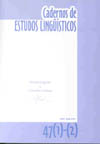Resumo
As a rule, researches on narrative acquisition have not given sufficient attention to the narrator. Threfore some studies seem to conceive the narrator as the child him/herself that produces the text. The narrative text is essentially defined by placing a narrator on stage – a voice which assumes the perspective from which the reported events are shaped. However, the narrator is linguistically and textually constructed. The aim of this paper is to reflect about infant written narratives through this point of view. The analysis intends to show that conceiving narrator as a narrative textual element implies to exclude knowledge from the child’s relationship with language. On the other hand, the analysis shows that the child’s relationship with him/herself and with his/her experiences is only possible through language, i. e., through the tension between langue and text. Even when the text configurates the narrator as a first person, there is not a coincidence between textual and grammatical narrator.
Referências
BAL, M. (1987). Teoría de la narrativa (una introducción a la narratologia). 2ª ed. Madrid: Catedra.
BAMBERG, M. (1991). Narrative as perspective taking: the role of emotionals, negations and voice in construction of the story realm. Journal of Cognitive Psychotherapy, v. 5, nº 4.
BAMBERG, M. & MARCHMAN, V. (1990). What holds a narrative together? The linguistic encoding of episode boundaries. Papers in Pragmatics, nº 4, pp. 58-121.
BANFIELD, A. (2001). Le nom propre du réel. In: MARANDIN, J-M. (ed.). Cahier J-C Milner. Lagrasse: Éditions Verdier, pp. 229-266.
BOSCO, Z. R. (no prelo). Notas sobre o nome próprio na aquisição da escrita. Texto apresentado no Seminário em homenagem à Cláudia Lemos, IEL/UNICAMP. A sair neste mesmo volume.
KOCH, I. G. V. (1995). Aquisição da escrita e oralidade. Cadernos de Estudos Lingüísticos, nº 29, pp.109-118.
KURODA, S-Y. (1975). Sur les fondements de la théorie de la narration. In: KRISTEVA, J. & al. (orgs.). Langue, discours, societé: pour Émile Benveniste. Paris: Éditions du Seuil, pp. 261-293.
LABOV, W. & WALETSKY, J. (1967). Narrative analysis: oral versions of personal experiences. In: HELM, J. (ed.) Essays on the Verbal Arts. Seattle: University of Washington Press, pp. 12-24.
DE LEMOS, C.T.G. (2002). Das vicissitudes da fala da criança e de sua investigação. Cadernos de Estudos Lingüísticos, nº 42, pp. 41-69.
DE LEMOS, C.T.G. (no prelo). Sobre o estatuto lingüístico e discursivo da narrativa na fala da criança. In: XIII Congresso Internacional da ALFAL. A sair em Lingüística.
DE LEMOS, C.T.G. (2000) Sobre o paralelismo, sua extensão e a disparidade de seus efeitos. In: V Encontro Nacional e I Encontro Internacional sobre Aquisição de Linguagem, PUCRS, Porto Alegre.
DE LEMOS, C.T.G. (1997) Native speakers intuitions and metalinguistic abilities. What do they have in common from the point of view of language acquisition? Cadernos de Estudos Lingüísticos, nº 33, pp. 5-14.
MILLER, B. & SPERRY, L. (1988). Early talk bout the past: the origins of conversational stories of personal experience. Journal of Child Language, nº 15, pp. 298-315.
PERRONI, M.C. (1992). Desenvolvimento do discurso narrativo. São Paulo: M. Fontes.
PETERSON, C. (1990). The who, when and where of early narratives. Journal of Child Language, nº 17, pp. 433-455.
REGO, L.B. (1986). A escrita de estórias por crianças: as implicações pedagógicas do uso de um registro lingüístico. DELTA, v. 2, nº 2, pp. 165-180.
ROJO, R.H.R. (1990). O desenvolvimento da narrativa escrita: como são os textos que as crianças escrevem? DELTA, v. 6, nº 2, pp. 169-193.
ROJO, R.H.R. (1989). O desenvolvimento da narrativa escrita: “fazer pão” e “encaixar”. Tese de Doutorado, PUC/ SP (inédita).
SALEH, P. B. de O. (2003). Sobre o narrador: a narrativa infantil escrita em-cena. Texto apresentado no 51º Seminário do Gel, UNITAU, Taubaté.
SALEH, P. B. de O. (2001). O que sustenta a narrativa infantil? Boletim da ABRALIN, v. 26, nº especial – 1, pp. 304-306.
SALEH, P. B. de O. (2000). Narrativas infantis sobre experiências vividas: uma questão de representação? Tese de Doutorado, IEL/UNICAMP (inédita).
SILVA, M. N. (1991). Simultaneity in children’s narratives: the case of when, while and as. Journal of Child Language, nº 18, pp. 641-662.
SOARES, M. E. (1994). Aspectos relativos à produção de narrativas por crianças de 3 a 9 anos. Cadernos de Estudos Lingüísticos, nº 26, pp. 79-102.
O periódico Cadernos de Estudos Linguísticos utiliza a licença do Creative Commons (CC), preservando assim, a integridade dos artigos em ambiente de acesso aberto.

